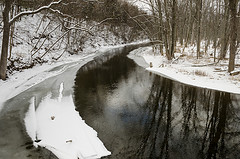
As we continue to endure winter-like conditions through the end of March, I am remembering last year at this time – 70 and 80 degree sun, punctuated by a devastating tornado season, including one in our own backyard, in Dexter.
What’s going on?
Surprisingly, this cold spring weather, like last year’s unusually toasty and tempestuous one, can also be traced to changes to our Earth brought by the ever increasing greenhouse gases we are spewing into our atmosphere.
The Weather Underground web site, co-founded by a University of Michigan Meteorologist, publishes a number of blogs and web pages dedicated to the impacts of climate change on the weather. A couple of their recent blogs give good perspectives on how local weather is globally connected.
Surprised by the robust levels of snowfalls this year in the midwest, east, and Michigan’s north? The Weather Underground’s Dr. Ricky Rood gives a good explanation for how climate change can result in larger snowfalls in some areas of the country in his recent blog. It turns out, snow is more likely at temperatures in the low 30’s range than at colder temperatures. So, as northern areas have warmer winters on average, we can expect to see heavier snowfalls. (For all you skiers and other winter sports enthusiastic, don’t get too happy — with the heavier snow events come the higher average temperatures, so that snow is not going to stick around).
How about this meat locker we seem to be trapped in this spring? Dr. Jeff Master’s recent blog explains that, due to arctic sea ice loss, the jet stream has contorted to bring cold weather to the Eastern U.S. and Western Europe and near -record warm weather to Greenland.
Some good news came with Sunday’s New York Times article about the increase in the use of renewal energy all over the world and how it is quite feasible for the U.S. to likewise reduce our dependence of fossil fuels. For instance, countries like Portugal get 40% of their electricity from renewables. In fact, 13 countries got more than 30% of their electricity from renewable energy in 2011. The U.S. number is 12%.
The article goes on to describe a Stanford University study showing that New York State (not known for high winds or sunny days) could easily produce most of its electricity from renewables by 2030.
So, take heart and encourage your state and federal officials to support our transition to clean energy!



